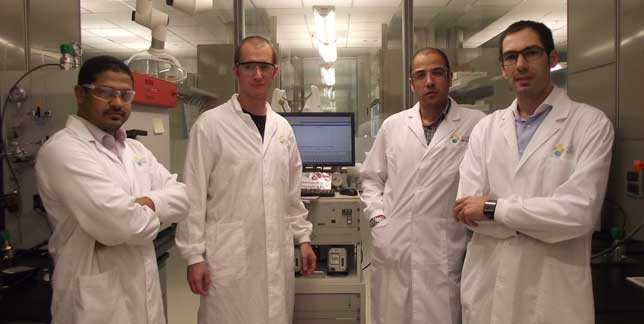KAUST-synthesized novel porous organic polymer may provide new solution for carbon capture

Researchers (L-R) Drs. Mohideen, Weselinski, Belmabkhout, & Guillerm from Prof. Eddaoudi’s Functional Materials Design, Discovery, & Development group.
“The last decades [have] witnessed an exponential and alarming CO2 rise in the atmosphere,” a research team led by KAUST Professor of Chemical Science Mohamed Eddaoudi notes in a paper recently published in and highlighted on the front cover of Chemical Communications (DOI: 10.1039/C3CC48228F). The all-KAUST team consisted of post-doctoral fellows Drs. Vincent Guillerm, Lukasz Weselinski, Mohamed Alkordi, M. Infas H. Mohideen, and Amy Cairns; Senior Research Scientist Dr. Youssef Belmabkhout; and Prof. Eddaoudi.
Due to the critical necessity of reducing CO2 emissions, economic and efficient CO2 capture technology is a top research priority in both academia and industry. However, current methods to capture CO2 are based on processes that are both costly and energy-intensive. To combat this, the KAUST team has embarked on a research program to develop and synthesize novel porous materials, such as porous organic polymers (POPs), which have the potential for enhanced CO2 adsorption properties.
The use of solid porous materials, metal organic frameworks (MOFs), or silica/carbon-based adsorbents is “a promising alternative to reduce the energy expense,” the researchers note. These microporous solids can act as scaffolds where amine functionality can be easily introduced in their tunable pores, thus strengthening their selectivity for CO2.
The new porous material (POP) the team produced using “judiciously selected organic molecular building blocks (MBBs)” is unique because it has aldehydes that are “amenable to post-synthetic functionalization by amines,” emphasizes first author Dr. Guillerm, who works in Prof. Eddaoudi’s Functional Materials Design, Discovery, and Development (FMD 3) group. “The resultant porous framework allows a facile, unprecedented, and anticipated one-step, quantitative, post-synthetic amine functionalization, which improves interactions between CO2 and a porous material,” the researchers explain.
When the team further investigated the CO2 adsorption properties of the POP, there was “a significant enhancement of the CO2 affinity at low coverage compared to the pristine material,” noted Dr. Belmabkhout. The POP showed a drastic increase of heats of adsorption of CO2 (from 33 to 50 kJ/mol), and also showed an improved potential for gas separation, with CO2/N2-calculated selectivity increasing by more than 10 times from 14 for the non-functionalized POP up to 155 for the amine-functionalized material.
Amine functionalization “considerably enriched the CO2 selectivity and improved the CO2 removal capabilities from N2 and CH4-containing gases,” the research team states. “This process is akin to post-combustion capture and natural gas upgrading applications.”
The team’s findings are of “prime importance,” notes the team, “as efficient gas separation is a key step to achieve at the industrial scale, due to the critical economic and ecological context worldwide. Indeed, the POP we have synthesized has potential to replace the existing energy-intensive liquid amine scrubbing, which is the current technology in use for CO2 separation.”
A unique feature of the team’s POP is the material’s combination of high affinity for CO2 coupled with easy regeneration of the POP without heating. “In most cases of amine-supported materials, the strong CO2-amine interaction leads to the formation of stable carbamate species that require additional energy, or heating, to regenerate the material,” say the researchers. “This feature is unique and further reinforces the potential of our material.”
Dr. Guillerm, Prof. Eddaoudi, and the rest of the research team hope that their paper reveals “there are still unexplored routes for improvement of separation agents.” Prof. Eddaoudi notes that “combining the careful choice of building blocks for the formation of porous sorbents, along with the variety of possible post-synthetic modifications, is the key to developing materials that will address critical energy and sustainability problems with reasonable cost and good recyclability.” The team believes these new materials will be the next generation of separation agents which will replace the current energy-intensive technologies.
Please enable JavaScript to view the comments powered by Disqus. comments powered by Disqus
